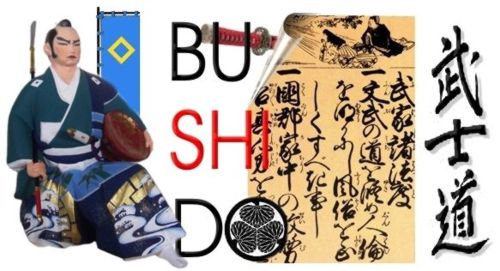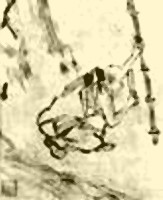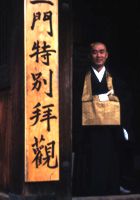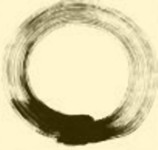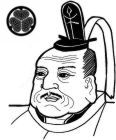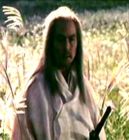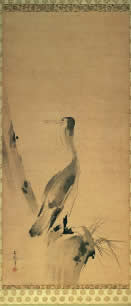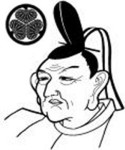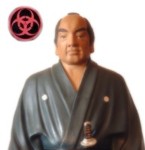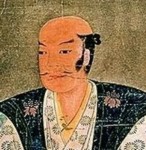B U
S H I D O
JAPANESE (TOKUGAWA)
WAY
OF THE WARRIORS
Inside the picture: Ceramic doll of Lord Hori Kyutaro, Oda Nobunaga's captain; the Hori clan's banner; an original page of the Tokugawaist 'bushido'; the Tokugawa clan's crest, and the word 'bushido' itself in kanji. Click here for the basic family crests of samurai clans. |
| Makoto | Hagakure | Ukiyo | Seppuku | Zen | Kamikaze | Yakuza |
| Shinto | Tatenokai | Tanaka | Jibakutai | Jieitai | Mishima | Chu Hsi |
![]()
|
Let me say this first so you'd get over it: If you are not Japanese, you cannot adhere to Bushido. Why? Because you can never live Shintoism, which is a 'national temperament' that can't take any convert; because mastering swordsmanship can be done by anyone in this solar system but the Bushido is not a rule for swordsmen and does not even have anything to do with martial arts, as you'll see a few bytes soon. And because the most famous and most exalted point of Bushido is loyalty, and this loyalty is ultimately to the Imperial House, and -- are you sure you are living for the Emperor of Japan?
Yoshida Shoin, mind you, was not just plain Mr Nothing. His thoughts were the backbone of the Meiji Restoration, and he is one of the few 'modern' people for whom the Japanese erected a shrine (see Yoshida's shrine at the Japanese Architecture section of this site). What you can adhere to is 'the way of the sword', kendo; not Bushido. Kendo is just stuff about swordsplay. The mixing-up between it and Bushido is as a matter of course natural to the Japanese samurai, but not to you; unfortunately they have been stubbornly mixed-up by the myriad martial art schools all around the globe. This thing named 'bushido', or the stuff that has been often anglicized into 'the way of the warriors', has always been at the back of the Japanese minds since before the first thousand years, as you have by now glimpsed at the previous pages. Only it wasn't even called that. Like so many Japanese stuff, even such a fundamental notion -- something that to a degree defines Japaneseness -- stayed unnamed for a very long time. It wasn't even defined, characterized or summarized, since Japan started to be in 660 B.C.E until the generally chaotic Ashikaga shogunate officially ruled (1136-1573). Now let's rewind a few inches.
The word 'samurai' was invented during the languid period of the history of Japan, stretched between the year 749 and 1185, that is portrayed in Takita Yojiro's movie Onmyoji, i.e. the Heian era (click here for everything about the Heian lifestyle). Before this era, the men we now refer to as 'samurai' were called 'bushi'. This word meant 'man of the horse and the bow' -- AKA 'the archer-cavalier'. That's why samuraihood is not inseparable from swords and swordsmanship, as the Tokugawa shogunate implanted in your mind later (click here for the original samuraihood). The samurai clan that embodied the warlike Japan in a professional sense was the Otomo, in the year 400. They were the guards of the Imperial Palace and most often went to war for the Emperor (that's how they got the name -- which was originally a job-description; see the making of Japanese names and their meanings at another page). Vaguely, the Otomos had sensed something like a class-consciousness, after witnessing so many noblepersons falling down from horsebacks and after tidying up their clumsy hunting sessions. But this feeling that they were different in a superior sense from the sedentary people hanging around the Palace never congealed into any real class-defining concept. Japan at the time was tribal, anyway; what mattered was one's clan and there was nothing to do with other clans. Then, since the year 749 until 1700, there had been something called 'The Six Arts' that every member of the warrior class was obliged to learn:
Those are comparable to the European 'Liberal Arts' (which were also American's basis of formal ed). There was no mention of swordsmanship, as you can see for yourself. Swordsmanship was added into the classic curriculae in 1700's, and no earlier. 'Samurai' was a derivation from the term 'sabu-rau', which meant, at the time, 'someone in service' -- the latter referred to anybody with the Imperial blood in his veins, so it included Princes and courtiers. All of those were civilians. So the man 'in service' was someone very much attached to weapons, since weapons are of course no civilian toy. Gradually, after a few years, the word 'sabu-rau' slid down into 'samurai' when spoken, and this finally found its way into the written vocab and it would stay there for good. But during the Heian era, no one used the word 'samurai' (not even 'bushi') in daily conversations. Those were parts of the lexicon of the Imperial House only, and even there only clerks used them. Only to the clerks was the archer-cavalier a member of a certain class.
The warrior class of Japan came out loudly no earlier than after the first thousand years, its foundations only got really secured by the Minamoto shogunate in 1185 (see the elaboration elsewhere at this site). Before 1185, what existed were scattered warlords with a few yards each to claim, so to speak; there was no overlord at the time, and everybody seemed to have been called 'Shogun'. Nationwide political power was, like I said before, civilian. Court Ministers were dominant, while the bunches of cavaliers-archers were to do what they were told to do, and be where they were put at. Minamoto Yoritomo ended this by shoguning himself in the way you are by now familiar with. The Minamotos, by overhauling the biz of warring and governing of Japan, made the samurai a class ('buke'). Click here for the Japanese socio-political ranks. All this was done by everything that made a class, beyond the limits of clannish views, encompassing everyone who made a living by the use of weapons. Minamoto didn't move to Kyoto but set up his own HQ at Kamakura, so that his men wouldn't, in his words, "get contaminated by the effeminate ways of the Imperial Court" and immune from "the influence unbecoming to warriors" -- such as party-going, picnicking, singing and dancing, and so forth. He based this on actual observation of the previous ruling clan, their enemies the Tairas, which used to be a formidable army in itself but later got reduced into just courtier-like men whose only difference from the noblepersons of the Emperor's Court was that they never fell from horsebacks. He also fixed the way a samurai must dress; discarding useless ornaments and getting rid of the courtiers' costumes that consisted of 12 to 16 robes worn at once (click here), stopping the habit of wearing makeup (men used to wear thick face-powder and lipstick at the time), and taking up Zen Buddhism as the "Buddhism of the samurai" -- favored because of its simplicity and "no fuss" principle (see the Zen page), which was strikingly different from the 'Buddhism of the Palace' that was overloaded with elaborate accessories and hours of rituals. Though the Minamoto samuraihood was still based on 'The Six Arts', the stress was put on archery and riding and such, while the rest of the six subjects were deemed secondary. This way, the Japanese warriors ceased to be the butt of courtiers' jokes, who until then were far too superior in 'unnecessary arts' such as calligraphy, poetry, music, and religious rites. Although snobs like Lady Murasaki still recorded stuff like the sneering courtiers who said "A Taira clan's bum is still more elegant and refined than Minamoto Yoshitsune at his best" (Taira clan was the arch-enemies of the Minamotos, while Yoshitsune was the greatest of all Minamotos), real life had been different now. For the first time in history, the Imperial Palace was forced to concede that they were, without any resemblance of mastery of martial arts, actually at the mercy of the warriors. This, of course, had been the truth since the very first day of Japanese history; only the courtiers never realized it until now, and, more bizarrely, the samurais themselves never realized it before, either. It was during Minamoto Yoritomo's reign that the word 'bushi' started to sneak into daily vocab, and uttered with pride by members of this finally-founded class. From now on, a more certain series of codes of conduct was to be adhered to by anybody born into a samurai family. The Minamoto codes of the warriors were concise and matter-of-fact -- Minamoto Yoritomo demanded from his soldiers to have:
Those surely look rather too simple to you now, and the third point seems meaningless, but they mattered a lot in 1185. You see, before the Minamoto's ascent, the samurai used to wear impractical armors to wars, which -- as the Taira clan clearly demonstrated -- were fatal. Lavish decorations on the samurai's body was the relic of the sedentary Heian era, and identical with the civilian Fujiwara clan's style, hence Minamoto wanted to get rid of it (see the Heian Era page if you have no idea what 'it' was). No matter how funny it sounds like today, it was normal for the Japanese to get the law talking about what they must wear; this had been a habit since the year 500 (see History of Japanese clothes). If whosoever happened to rule really knew better than everyone else, such a trickled-down effect was good. The cumbersome Heian and Taira styles even played a part in ensuring the latter's utter defeat in the final battle against the simply-dressed Minamoto warriors in 1185's battle of Dan no Ura (I'm not kidding; see History of Japanese Armors). Point #2 is obvious; the archer-cavalier had been THE samurai since 660 BCE. 'Good pedigree', though, didn't mean that you had to come from the Imperial Family or famous warlords' clans. What Minamoto Yoritomo meant was that from your grandpa's time, at least, your family had to have been proven to be loyal Minamoto vassals. That's all. In 1186 he even immediately amended this rule to include more soldiers, by stating that your family might not have been a staunch Minamoto supporters since your grandparents were still kicking, but if they or your dad or your uncle or so were proven to have been victims of the Fujiwara or Taira clans' intrigues, you could be assured that your pedigree in the eyes of this government was thereby 'good'.
Now, what is this unnamed and undefined 'way of the warriors'? It is the same salad of the major Japanese beliefs as I have wordily explained earlier (see another page): the principles or codes adhered to by all people in Japan whose jobs were related to the use of weapons, and framed the minds of those who never even saw knives all their lives, too. This string of codes was a convention handed down from father to son, unwrittenly. That's why some 'authorities' (i.e. historians that 7 out of 10 tend to believe the verdicts of) have been describing this unwritten law as something magically evolved by itself out of the collective Japanese consciousness; it was, they say, 'organically growing through the early centuries of Japanese history'. Some even go so far as to mention it as an everlasting undercurrent that originated at the descent of the Goddess of the Sun herself in the Japanese Genesis. So, as there was no samurai Moses bearing exact laws of the Japanese warriors down the Sinai, the only way for you to know that there were such laws was by observing how they were applied case by case. For instance, you overheard a warlord scolding his kid, "Where in this world was your head? Didn't you think two horses were better than the silk your second concubine demanded every other weekend?" (this is not entirely fictitious; Lord Imagawa Yoshimoto of Suruga often delivered such a line) -- frugality was clearly there a value seen as the best in all weather, though you would find it hard to nail down any real-life application of this law. Or you saw a samurai pulling weeds at the crumbling grave of his dad and mom, and there you had filial piety. Or you happen to see a soldier in swordsplay, and his seeming abandon won him the match, so you knew he had practiced the Tom Cruisian (i.e. Sanada Hiroyukian) 'no mind' principle. During the so-called 'Warring States Period', i.e. the latter half of the Ashikaga shogunate's years, and through which Oda Nobunaga, Toyotomi Hideyoshi and Tokugawa Ieyasu grew up, there was still no such a thing as 'bushido'. You could say it to those illustrious warriors ("Excuse me, do you know bushido?") and got a 'duh' look. "Turn left here, and then thru the Hakone pass, and straight from there is Kyoto," Toyotomi Hideyoshi would (be the only one who) have replied to you. Tokugawa Ieyasu would have contemplated on your question for approximately 25 years before he was sure of what was that about. While Oda Nobunaga's reply would have been too quick for you to catch: "[sound of cutting bones]". They lived the thing, you see; they didn't, as their ancestors never did either, bother to attach a name to it or a 'universal' definition of it. The haziness was very much the doing of Zen Buddhism. This branch was the one Japanese warriors since Minamoto days infused themselves with (see another page). The term 'the way of the warriors' itself smacks strongly of Zen -- 'the Way' has been the Zen priests' keyword. Just in case you have forgotten what kind of stuff Zen Buddhism is, here are fragments of real-life Zen:
Then you'd know that a Zen Master is a man who always has to have the last word on anything. Anyway, so Zen is about 'The Way'. Asking 'which way?' has been barbaric, to the believers of this Buddhism. So is the case with 'the way of the warriors'. It was assumed that every Japanese knew what it was -- and probably every Japanese did. Click here for more about Zen.
In 1340, Kitabatake Chikafusa wrote a book about the history of Japan based on the Shintoist beliefs (click here for everything about Shintoism). In it were outlines of what the samurai must do and be; this, too, was a source of the Bushido. Then a courtier and Imperial Minister named Ichijo Kanera released his own book in 1470, that boldly synthesized Shintoism, Buddhism and Confucianism. In this tome, 'the way of the warriors' was also just underlying the whole thing without being specifically nailed down. They didn't need to, for it all went without saying.
The problem only occured when some non-Japanese started to sniff around the samurai in 1400's. Then a definition was felt like the best way to shoo these nosy foreign ignoramuses off and fend the Japanese from the annoyance caused by their FAQ's. Whether this was in his mind or not, since his territory was largely deep inland and nearly impenetrably mountainous, Lord Takeda Shingen of Kai (1521-1573) hinted rather boldly at this 'way of the warriors' in his random lectures. The Imagawa clan of Suruga (in power since 1400's until 1560) had done the same earlier. But both the Imagawa chiefs and Takeda Shingen didn't say 'bushido' or 'the way of the warrior'; they hit this key in a maddeningly roundabout way via some detours to Confucianism and what, if coming out of lesser mortals' keyboards, would have been dubbed 'rambling'. Oda Nobunaga (1534-1582) never had time to sit down and scribble anything impractical, so he skipped this. Toyotomi Hideyoshi (in power between 1583-1599) was too busy writing personal letters and having public events, so he didn't do it either. Tokugawa Ieyasu (1543-1616), though, had some years off after cementing the foundation of his clan's grip upon Japan. So he started to put what had been hitherto orally and randomly hinted at into words that define and kick out. This was the famous and dubious Tokugawa Testament, which slid down into the so-called Laws of the Samurai Clans ('Buke Hatto' in Japanese), in 1615. He did this by assembling whatever looked like promising some benefit to the Tokugawa clan's reign, from every source he could tap -- Confucianism, Zen Buddhism, classical Chinese scrolls, domestic anonymous wisecracking, and his own thoughts about the matter. Tokugawa Ieyasu's better part of offsprings brooded over what he left behind and made their own laws, but never to deviate from the patriarch's legacy. The Testament itself was taken by the successive Tokugawa Shoguns as unchangeable as sacred religious texts.
He said things such as 'the way of the warrior is acceptance of death', and so forth. In this tome, 'bushido' started to get blurted out, but still rather hazily. (If you have time to waste and no laundry, count how many times Musashi said 'the Way' there. And then tell me if you really truly know what he's talking about.) Anyway, five is a magical number for Zen Buddhists; Tokugawa Ieyasu even put it on one of his series of battle-banners (click here for battle-banners of 16th century warlords, or click here for the extravagant Buddhism -- yup, such a thing is proven to be possible after all -- shown by the Tokugawa mousoleum in Nikko). Japanese tombstones, by the way, have been based on the 'five rings' ('gorinto' in Japanese; click here for pictures) of the five elements of this universe: earth, water, fire, wind, and an absolute void. These were what Miyamoto Musashi had in mind so that his book was called 'Five Rings'.
The term 'bushido' was used really boldly and in the way you encounter it today no sooner than in 1717, when the Shogun was Tokugawa Yoshimune (he'd reign until 1744). This one Tokugawa -- who had never seen war all his life -- surpassed even his already notoriously penny-pinching ancestor Tokugawa Ieyasu; under his reign, the whole Japan was forced to wear coarser kimonos in bleak colors (so that those could stay unwashed as long as possible without showing too much dirt -- click here for what this Shogun did to the Japanese kimono culture). Everybody was subjected to the most miserly diet ever, in their twice-meals-a-day; a little cup of rice, one slice of dried fish, a little morsel of pickled peach. It's almost natural that such a personality ended up ruminating about virtues, something that -- as you know by yourself -- is not likely to get thinkable in the midst of fun and affluence. The mania of excessive frugality ran in the Tokugawas' DNA -- at least in the form of a wish. However, it wasn't Tokugawa Yoshimune who filled up the Bible of this subject, but a man named Yamamoto Tsunetomo of Saga, a vassal of the Nabeshima clan (click here for complete maps of Japanese warrior clans) and a man who obviously had an itch to philosophize every morning or so. But it wasn't Yamamoto who wrote it down. It was his fan named Tashiro Tsuramoto. It was a Socratic tome, where Tashiro played Plato. It was titled Hagakure Kikigaki. The English translation of this won't be 'The Way of the Warriors', but a floatingly poetic 'In the Shadow of the Leaves'. This marked the launch of 'bushido' into this planet the way it is. And the release of the Hagakure also reset the samuraihood for eternity by fixing it to be equivalent of swordsmanship -- while samurai and swords had never been interchangeable before (see the page about original samuraihood). Tokugawa Yoshimune, to his credit, wasn't included as a footnote to the history of the Bushido only because he happened to rule at the time. He did actively campaign for it, called all people to observe it, and tried to cajole the warrior class into joining his 'Back to Ieyasu' project. He did all those because the samurai's 'effeminacy' had reached an alarming stage since before his own ascension. No war, only brawls at the red light district. No martial art practice, only the killings of peasants and townsfolks whenever a sworded person happened to be in his bad mood. Tokugawa Yoshimune, like every single one of his predecessors, had been taught about the Tokugawa Testament and Ieyasu's ways; he realized acutely how yawning the gorge between the quality of the warrior class of his patriarch's times and his own was.
The book Hagakure was about one thing: if you are a samurai, live as if you have already been dead, every day of any week. That, of course, was nothing new. By the time Hagakure was launched, all of its contents had been there all along since the birth of Japan itself on February 11, 660 BCE (I don't make this up. See History of Japan). And every scrap of 'live like you've been dead', and so forth, had been there for 1,100 years before the book was even written -- the example itself is just the usual Buddhist thing related to their steadfast belief that this world, this life, is nothing real; hence the ubiquitous term 'the floating world' ('ukiyo') -- that lamentably was turned over to the mundane lexicon in the 18th century Tokugawa reign and made to mean the lustful idea of having fun at the Flowertown ('hanamachi'; click here), and which, at the end of 1990's, made search-engines to get stuck whenever requested to find 'pictures of the floating world' ('ukiyo-e'). Apparently the family-friendly search engines never knew that the term actually never means 'pix of nude geisha'. Anyway, the most commensical of all known religions in the world might be Buddhism for the smooth acceptance of death as life -- because it, no matter what you wish, is. You will die because you have lived. It's that simple. No fuss, no sugarcoating, no blah blah blah justifying. That is the samurai's way, you say; the truth is, that is the human way. What matters is not life and not death, but what to be and to do in-between. What concerned the samurai, then, was just how to die, for what and for whom. The entire samurai ethics evolved around the three questions. This, too, is the essence of living a human's life -- and not monopolized by the Japanese, let alone just by their warrior class. The samurai principles only stand out, mind you, because they are seen from the largely Semitic religions' eyes, in this case Christianity. The horror striking every God-fearing caucasian upon hearing of honorable suicide ('seppuku'), the constant failure to digest the system of the geisha (even you, right now, might still be unable to differ it from prostitution, right?), and so on, have been happening since 1400's because of the Christian mental glasses that are used to observe the Japanese. Thus, Tashiro only wrote down what already had been a fact for ages: a samurai must get ready to die (some insist that 'to kill' is more like it) any moment for his lord. Disappointingly, the Hagakure writer Tashiro and the 'Socrates' Yamamoto themselves died in peace and for nobody. None of the two had ever been to war all their lives; not even a duel was recorded in their CV's.
Nothing. The Tokugawa shogunate's samuraihood in 1717 was beyond repair. The merchant class started to made their fangs felt by the warrior class, and the samurai status was 'on sale' quite openly that it became a collective secret. Tokugawa Yoshimune's 'Back to Ieyasu' project never got materialized; something very understandable because it was against the vogue. And though the decline of samuraihood wasn't markedly sharp, it went on nonetheless. By 1800, the Tokugawa samurai practiced martial arts only to fend off farmers' revolts that erupted everywhere around the realm, while the real powerful class was the merchant class, quite beyond their own expectation, and the extent of of which, luckily for the warrior class, the merchants themselves were not really aware. So, was Bushido born for nothing? Well, not exactly. Everything in the Tokugawa world was regulated down to the smallest detail. It was time to have the most important of all -- rules about being samurai -- got some neat list substituted the namelessness, undefinedness, and the alternative of that, which were the overweight rambling tomes. The formulation of Bushido via Hagakure and Tokugawa Yoshimune's campaign made it all clear and easy to digest even by the most airheaded samurai, and provided other classes with a model to make similar strings of rules. Let's recall again what Ishida Baigan (1685-1744) wrote about Bushido. Ishida, be kind to remember, was not a samurai. He was, on the contrary, one of the most famous leaders of the merchants' movements. But the Tokugawa's Bushido had been so deeply indoctrinated that even this 'dangerous element' of the shogunate saw the world thru Bushido:
So, in conclusion, while the Minamoto clan cemented the foundation of the warrior class of Japan in which martial arts were vocations, the Tokugawas made the same old martial arts as in 'fine arts'. They seem to have in a way anticipated the flood of 20th century tourists from dojos established by Japanese migrants at places such as Michigan and Manchester. From the Tokugawa on, everything around the Japanese martial arts were knickknacks and decorations. I said the Bushido was just a written version of what had been the Japanese samurai's ethics of eternity. That's true, but there was one crucial point made when Shogun Tokugawa Yoshimune campaigned for it. And in this campaign, the Tokugawa's Bushido was very different from the un-named codes of conduct followed by the samurai since 1185. What Minamoto Yoritomo fixed was something that grew out of real life, something that spontaneously developed in the relationship between samurai and their lord and among themselves. The Tokugawa's Bushido, on the other hand, was a systematic code born after philosophical disputes, in which the warlike qualities were adapted to the life in peace, and the adaptation was done for the purpose of keeping the Tokugawa clan in power. Minamoto's unwritten convention bound the samurai alone. The Tokugawa's Bushido tied up everybody, whatever their class was, because of the political motivation that of course necessitated participation of everyone in order to ensure safety and preservation of the social order of their times, so the Tokugawa clan could continue to rule the country. The martial-sounding name, 'way of the warriors', only means it came from that class, but not exclusively its own. There, you have the Bushido for real. Now, what is bushido all about? A mixture of Buddhism, Shintoism, Confucianism and such were as a matter of course the Bushido if we are to talk about it in general (see the previous page again). However, here is another difference from the samurai codes of the Minamoto days until 1717: much of the stuff was concocted based on the philosophy of a rather unknown Chinese, Chu Hsi (1130-1200), official philosopher of the Sung dynasty. This was imported in Minamoto's days, but only in 1600's it gained immense popularity because the Shogun and people around him fell for it heavily. An academy was established in 1633 solely for studies of this 'neo-confucianism'. In 1690, the academy was enlarged and given the name of Shohei-ko, and this was the Edo (Tokyo) University in Tokugawa Yoshimune's reign. The chair as the head of this university was hereditary, held by Hayashi clan after Hayashi Razan. Why the virtually unknown imported item got so exalted? Because the Japanese never got any patience with abstractions and philosophical musings; Chu Hsi's Confucianism was nothing but the most practical ethics that can get practiced right away, aiming at the so-called 'cultivation of virtue' -- i.e. good behavior, which is always much easier to build than to instill the abstract thing called 'morality'. This behavior was to get regulated thru 'the Bushido's Seven Virtues'. Click on to the next page for what Chu Hsiism is all about, what the 7 virtues are, what was the dark side of Bushido, how your Bushido came to life, why Bushido was only spread since 1930, why it only got its current popularity since 1970, what makes the Bushido today, and so on. |
|||||||||||||||||||||||||||||||||||||||||||||||||||||||||||||||||||||||||||||||
Site & Rap © 1996, 1997, 1998, 1999, 2000, 2001, 2002, 2003, 2004, 2005, 2006 Nina Wilhemina
All rights reserved. Every borrowed image at this site is put for non-profit educational purposes only.
HOME
 LINKS
LINKS
 CONTACT
CONTACT
 CREDITS
CREDITS
 COMMENTS
COMMENTS
Sources tapped for this page: Nihon Shakai no Kazoku teki Kosei (Tokyo: 1948); Kono Shozo, Kokumin Dotoku Yoron (Tokyo: 1935); Anesaki Masaharu, Nichiren, the Buddhist Prophet (Cambridge, Mass.: Harvard University Press, 1916); Robert Cornell Armstrong, Light from the East, Studies of Japanese Confucianism (University of Toronto, Canada, 1914); Sasama Yoshihiko, Nihon kassen zuten (Yuzankaku, 1997); William Aston, Shinto: The Way of the Gods (London: Longmans, Green, 1905); Ruth Benedict, The Chrysanthemum and the Sword (Boston: Houghton Mifflin, 1946); Charles Eliot, Japanese Buddhism (London, 1935); Futaki Kenichi, Chuusei buke no saho (Yoshikawa Kobunkan, 1999); Kiyooka Eichii, The Autobiography of Fukuzawa Yukichi (Tokyo, Hokuseido Press, 1934); Konno Nobuo, Kamakura bushi monogatari (Kawade shobo shinsha, 1997); Nukariya Kaiten, The Religion of the Samurai (London: Luzac, 1913); A.L. Sadler, The Beginner's Book of Bushido by Daidoji Yuzan (Tokyo: Kokusai Bunka Shinkokai, 1941); A.L. Sadler, The Makers of Modern Japan (Tokyo: Tuttle, 1978); Satomi Kishio, Nichirenism and the Japanese National Principles (NY: Dutton, 1924); Suzuki D.T., Zen Buddhism and Its Influence on Japanese Culture (Kyoto: The Eastern Buddhist Society, 1938); Henri Van Straelen, Yoshida Shoin (Leiden: Brill, 1952); Robert Bellah, Tokugawa Religion; Sato Hiroaki, Legends of the Samurai (Overlook Press, 1995); Masaaki Takahashi, Bushi no seiritsu: Bushizo no soshutsu (Tokyo: Tokyo daigaku, 1999); Stephen Turnbull, Samurai Warlords (London: Blandford Publishing, 1992); Paul Akamatsu, Meiji 1868, Revolution and Counter-Revolution (Allen & Unwin, 1972); Nitobe Inazo, Bushido, The Soul of Japan (Tokyo: Tuttle, 1970); Paul Varley and Ivan Morris, The Samurai (Weidenfeld, 1970); Inoguchi and Nakajima, The Divine Wind: Japanese Kamikaze Force in World War II (Hutchinson, 1959), Seki Yukihiko, Bushi no tanjo (Tokyo: NHK, 2000); Amino Yoshihiko, ed. Edojidai no mikataga kawaruho (Tokyo: Yosensha, 1998). |
